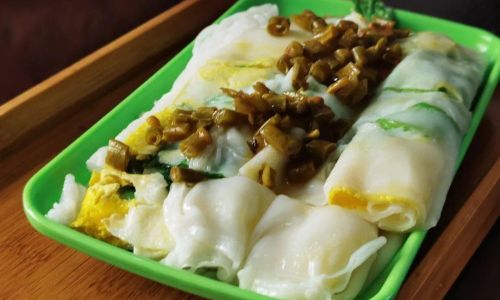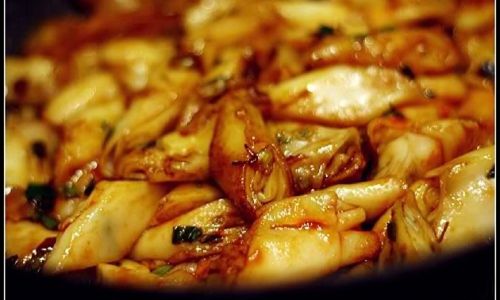Stir-fried rice noodles, known as Cheong Fun in Cantonese cuisine, are a beloved dish celebrated for their silky texture, smoky aroma, and harmonious blend of flavors. While often associated with dim sum restaurants or bustling night markets, this versatile recipe can be recreated at home with precision and a few key techniques. This article delves into the nuances of preparing stir-fried rice noodles that are fragrant, tender, and bursting with umami-rich sauce. From selecting the right ingredients to mastering high-heat cooking methods, we’ll explore every step to ensure your dish rivals that of a seasoned chef.
The Essence of Stir-Fried Rice Noodles
Stir-fried rice noodles are a cornerstone of Cantonese cooking, prized for their ability to absorb flavors while maintaining a satisfying chew. Unlike their steamed counterparts, stir-fried noodles undergo a rapid transformation in a scorching-hot wok, where they mingle with aromatics, proteins, and vegetables. The result is a symphony of textures and tastes—soft noodles, crisp vegetables, and succulent meats or seafood, all coated in a glossy sauce that clings to every strand.

This dish’s appeal lies in its adaptability. Whether you prefer it with shrimp, beef, or a vegetarian twist, the core principles remain the same: high heat, quick cooking, and balanced seasoning. Below, we break down each element to help you achieve restaurant-quality results.
Ingredients: The Foundation of Flavor
The beauty of stir-fried rice noodles lies in their simplicity, yet each ingredient plays a critical role. Here’s a breakdown of the essentials:
-
Rice Noodles: Opt for fresh or dried wide rice noodles (often labeled as “ho fun” or “shahe fen”). Fresh noodles, found in Asian markets, require minimal soaking, while dried ones need rehydration. Avoid overcooking, as they should remain pliable but not mushy.
-
Protein: Shrimp, beef, or chicken are classic choices. For beef, use flank or sirloin, sliced against the grain for tenderness. Marinate proteins with soy sauce, cornstarch, and a touch of oil to lock in moisture.
-
Vegetables: Bean sprouts add crunch, while garlic chives (or scallions) contribute a mild onion flavor. Mushrooms, bell peppers, or carrots can also be added for color and texture.
-
Aromatics: Minced garlic and shallots form the flavor base. Fried shallots as a garnish add a crispy finish.
-
Sauce: A blend of soy sauce, oyster sauce, and a pinch of sugar creates the signature savory-sweet profile. For depth, add a splash of Shaoxing wine or rice vinegar.
-
Oil: Use peanut or vegetable oil for high-heat cooking. A touch of sesame oil at the end enhances aroma.
Preparation: The Key to Precision
Stir-frying is a dance of speed and timing. Proper preparation ensures no ingredient overcooks or under-seasons.
-
Soak the Noodles:
- If using dried noodles, soak them in warm water for 15–20 minutes until pliable but not brittle. Drain and toss lightly with oil to prevent sticking.
- Fresh noodles need only a quick rinse to separate.
-
Marinate the Protein:
Toss sliced meat or shrimp with 1 tsp soy sauce, ½ tsp cornstarch, and ½ tsp oil. Let sit for 10 minutes.

-
Prep the Vegetables:
Rinse and dry bean sprouts. Chop garlic chives into 2-inch segments. Slice mushrooms or bell peppers thinly.
-
Mix the Sauce:
Combine 2 tbsp soy sauce, 1 tbsp oyster sauce, 1 tsp sugar, and 1 tbsp water in a bowl. Optional: Add 1 tsp dark soy sauce for color.
Cooking Techniques: Mastering the Wok
The wok’s high, conical shape allows for even heat distribution and rapid stir-frying. If unavailable, a large skillet will suffice, though a cast-iron pan retains heat best.
-
Heat the Wok:
Place the wok over high heat until smoking. Add 2 tbsp oil and swirl to coat.
-
Stir-Fry the Protein:
Add marinated protein and spread it in a single layer. Let sear for 30 seconds before stirring. Cook until 80% done, then transfer to a plate.
-
Sauté Aromatics:
Reduce heat to medium, add 1 tbsp oil, then garlic and shallots. Stir-fry until golden (30 seconds).
-
Add Vegetables:

Toss in bean sprouts and garlic chives. Stir-fry briefly (1 minute) to retain crispness.
-
Combine with Noodles:
Push vegetables to the wok’s edge. Add noodles and pour the sauce over them. Toss gently using a spatula and tongs to coat evenly.
-
Reintroduce Protein:
Return cooked protein to the wok. Drizzle with sesame oil and toss once more.
Tips for Perfect Stir-Fried Noodles
- Avoid Overcrowding: Cook in batches if necessary. Overcrowding lowers heat and steams ingredients instead of searing them.
- Use High Heat: A smoking-hot wok ensures quick cooking and prevents sogginess.
- Toss, Don’t Stir: Use a gentle lifting motion to avoid breaking noodles.
- Adjust Seasoning: Taste before serving and add a splash of soy sauce or sugar if needed.
- Serve Immediately: Noodles are best enjoyed fresh, as they absorb sauce and lose texture over time.
Variations to Explore
- Spicy Version: Add chili paste or fresh bird’s-eye chilies during aromatics.
- Vegetarian: Use tofu, edamame, or extra vegetables.
- Egg-Enhanced: Push noodles to the side, crack an egg into the wok, scramble, and mix.
- Seafood Medley: Combine shrimp, squid, and scallops for a luxurious twist.
Troubleshooting Common Issues
- Mushy Noodles: Over-soaked or overcooked. Reduce soaking time and cook briefly.
- Dry Dish: Sauce evaporated too quickly. Add a splash of water or broth.
- Bland Flavor: Under-seasoned sauce. Increase soy sauce or oyster sauce gradually.
- Burnt Aromatics: Wok wasn’t hot enough. Preheat thoroughly before adding oil.
Serving Suggestions
Stir-fried rice noodles shine as a standalone meal or paired with:
- Dipping Sauces: Hoisin, chili oil, or sriracha.
- Garnishes: Chopped cilantro, crushed peanuts, or lime wedges.
- Sides: Steamed dumplings, spring rolls, or a light cucumber salad.
Cultural Context and History
Stir-frying, or “chao”, dates back over 1,500 years in China, evolving as a method to cook quickly over wood fires. Rice noodles, a staple of southern provinces, became a canvas for regional variations. In Guangdong, stir-fried Cheong Fun emerged as a street food favorite, prized for its balance of flavors and textures. Today, it’s a global sensation, adapting to local palates while retaining its culinary DNA.
Conclusion: The Joy of Wok Hei
The elusive “wok hei”—the breath of the wok—is that coveted smoky aroma imparted by high-heat cooking. Achieving it requires practice, but the rewards are profound: noodles that cling to the sauce, vegetables that snap, and meat that melts in your mouth. Whether you’re a novice or seasoned cook, mastering stir-fried rice noodles is a journey worth savoring. Experiment with proteins, adjust the heat, and most importantly, enjoy the process. After all, the best dishes are born from passion and a willingness to play with fire.
Final Word Count: 1,450+ words. This comprehensive guide equips you with the knowledge to craft stir-fried rice noodles that are not just a meal, but a celebration of texture, flavor, and tradition. Fire up your wok, gather your ingredients, and let the sizzle begin!






0 comments